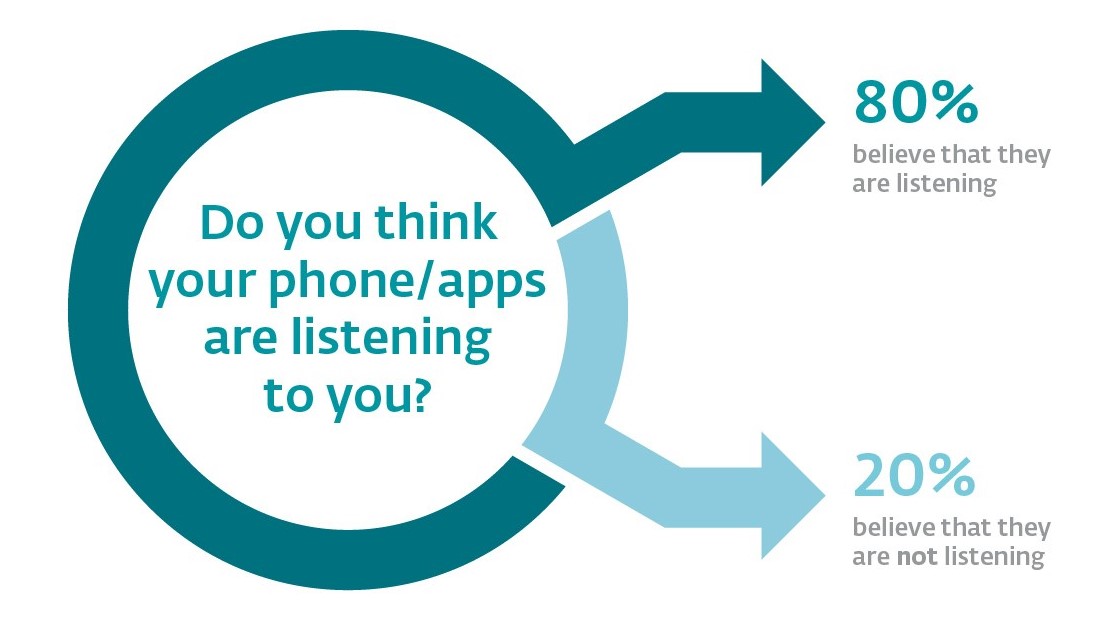We have all heard that our phones could be listening to our everyday conversations in order to then bombard us with targeted adverts. Is there any truth to the matter, though? Have you ever tested this theory and talked about an obscure product with friends and then waited patiently to see whether an advert for that vacuum sealer or scented colander you mentioned appeared in your social media feeds? If it never came up, you may simply have forgotten about your test. If it did appear, however, then you’d probably have thought that your phone must have been listening to every word and was now invading your privacy.
There has been plenty of discussion about whether social media apps are able to listen in and many people have even noted seeing obscure targeted adverts appear in their feeds after speaking about them in daily conversation. However, this would be illegal in most countries without the user being completely aware of this, let alone difficult for the companies to perform.
So, I decided to find out what Twitter users think about the subject and created a poll asking if people think their phone or apps are listening to them. I received 234 votes, with 80% of people claiming that their phones are listening to them. This is a very interesting outcome, especially when most of my followers and retweets came from the InfoSec community.
Let’s just take a moment to think about if they were able to listen. First, we will need to park the idea that it would be a gigantic scandal in the waiting. Indeed, if it ever came out, the online services involved would be sued to the hills and back, which would possibly take them out of business and never to be seen again.
The numbers
Let’s discuss the sheer volume of data required to listen to our conversations. When recording to audio, general talking would be consumed at around 115 megabytes per hour (15-bit depth, in mono, calculated here). So, for a normal day, let’s say we are awake for about 15 hours on average (not considering your sleep talking and inner thoughts – although that would be interesting!).
However, we don’t all speak the whole day long, so let’s consider only a quarter of that. We are now looking at around 430 megabytes of audio per day per person. There are 800 million people on Instagram so if they recorded our conversations from every one of us on Instagram, they would need to be storing around 344 petabytes (1015 bytes) of data a day. To put that into perspective, there are around 2,500 petabytes (or 2.5 exabytes; 1018 bytes) of data created each day around the world at our current pace. Would social media platforms really be able to process such an amount of data per day even if it were compressed?
The most likely theory is that social media wouldn’t realistically be able to deal with this amount of data pouring in each day, let alone examine it and make use of it. It is far easier to analyze the data of individuals in other ways and to profile them from data that is already online. Such profile building includes: your age (either from the date of birth you have entered or via age-guessing software), your sex, a photo analysis to determine your interests, reading captions and hashtags in posts and the likes you give – even the amount of time you spend on posts that you don’t otherwise engage with.
Their algorithms are then able to determine if you are single, in a job, have children, a pet, own a car, your style of clothing, your hobbies, your future interests …, the list is virtually endless. They are even able to make a well-informed guess as to what your next purchase will be before you have even given it much thought.
The theory surrounding social media listening suggests that if you don’t want to have your conversations monitored, then you must turn off the microphone in the app. You may have noticed that when you turn off the microphone in Instagram, then you aren’t able to post to Stories. This wouldn’t be the end of the world for me, so I decided to test it.
The test: part 1
To try and entice some interesting adverts and make this a serious test, I left my phone’s microphone on for 2 weeks and had very random (and hilarious) clear conversations about 3 random topics which I had not spoken about before:
- How I am now a vegan;
- That I am wanting to purchase some high heels;
- And I am thinking of building a swimming pool in my back garden.
These are the adverts I actually received on Instagram:
- Snowboarding goggles;
- Waterproof shoes;
- An electric skateboard;
- Cough medicine;
- Gin;
- VW cars
I didn’t get anything to do with vegan food, high heels or how to build a swimming pool in my back garden which I am gutted about as I would have loved to eat avocado on toast on my inflatable pool whilst wearing a pair of Gucci heels.
Ok, so there was nothing that I had spoken about in my ads, but I was still interested in the ads I receive. It doesn’t take a genius to work out that I am into the products above and likely to buy them at some point. From my Instagram you will quite easily notice that I’m late 30s, married, a family man, into the outdoors and particularly extreme sports.
But then here’s the interesting part. Have I spoken about anything relating to the above list recently? Maybe there is a sound reason for each one being there, so here is my theory for being delivered each advert:
Snowboarding goggles: I have mentioned to various people that I am going snowboarding soon but are the apps listening? No. I follow various snowboarding companies and regularly like their posts. Furthermore, it’s December as I write this blog, so it’s high season in the northern hemisphere (Instagram knows that about me too, from location data from my phone and address information in my profile) for winter sports.
Cough medicine: I ran this test in December 2019 and yes, I was coughing a little, but I knew more people with colds than not at the time, so again; it was high season for advertising for this here. Plus, there were even cough adverts on TV at the time, but I don’t think TV adverts are targeting us tailored to what we are saying online. Yet.
VW cars: I am 38 with a young family and like the outdoors. I fit the demographic of someone who would like a VW car.
The test: part 2
I then turned my microphone off for 2 weeks in Instagram and received adverts from the following:
- HopHouse bee;
- Snowboard travel bags;
- Morrisons supermarket cheese board selection;
- Nike footwear;
- Cadbury chocolate.
Snowboard travel bags are similar to what I had before. Hophouse beer, the supermarket cheese board and Cadbury’s chocolate are all most likely because this test was run two weeks before Christmas. The Nike one is interesting as I have been shopping online for Nike shoes recently, so I imagine this data was gleaned from across the various devices I viewed Nike shoe pages from while concurrently logged into Facebook.
What we are cognizant of is the fact that these companies know a lot about us. Their algorithms power their business and it is what makes them profitable. The algorithms aren’t there to help bring us together; they exist simply to make money and expand on targets manifested via micro-targeted advertising. They aren’t legally allowed to listen to us without our knowledge, yet it may seem so with countless examples of people trying to “prove” that they are listening. Some people claim that it doesn’t bother them, but others find it an invasion of their privacy. Just for the record, Amazon offers people to opt-in to having its Alexa service listen to their conversations for more tailored adverts.
Who owns what data?
The big question for me is: Are the social media giants able to read what we write in messaging apps WhatsApp, Facebook Messenger and Instagram Direct Messages? These are all owned by Facebook, so the question could be raised: Although the messages transmitted over some of these services are, or can be, encrypted to protect them from eavesdropping by third parties (such as law enforcement or authoritarian governments), can the service operators still read message contents to enhance the targeting of ads to their users?
Whatever is going on, their individual, unique, “gold-dust-like” algorithms are impressive, and no one really knows how they work, or what they really know about us apart from one thing – they capture a ton of relevant, key, personalized data and it is worth millions of dollars to them. Remember, if you get all these products for free, then you must be the product.






